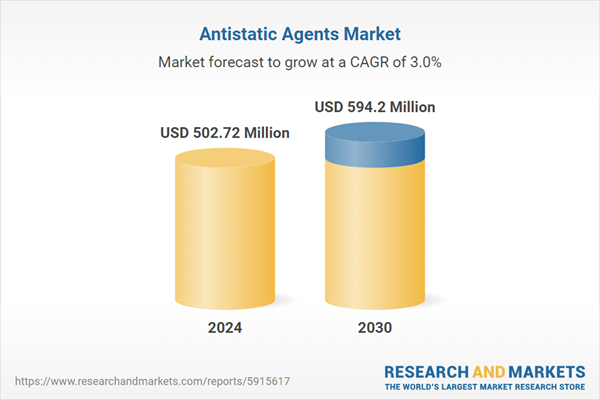Speak directly to the analyst to clarify any post sales queries you may have.
10% Free customizationThis report comes with 10% free customization, enabling you to add data that meets your specific business needs.
The market continues to grow steadily due to technological advancements, increased automation, and expanding industrial applications. With evolving material science and heightened demand for safety and product reliability, the need for effective antistatic solutions is increasing. However, the industry must also address regulatory complexities and consumer expectations for environmentally friendly formulations. Innovation and adherence to regional compliance will be vital for sustaining growth in this competitive and evolving market landscape.
Key Market Drivers
Industry Expansion
Rapid expansion in sectors like electronics is significantly boosting the demand for antistatic agents. In high-precision manufacturing environments, such as semiconductor fabrication and electronic assembly, managing electrostatic discharge is crucial. Antistatic agents mitigate the risk of component failure caused by static buildup, ensuring device performance and safety.With the global electronics industry on a growth trajectory, supported by initiatives like India’s Production-Linked Incentive (PLI) scheme and projected expansion to USD 300 billion by 2025-26, demand for antistatic solutions is expected to rise sharply. As electronic products become more compact and advanced, maintaining ESD control through reliable antistatic treatments is critical. This growth is not only limited to production but spans the entire supply chain - from packaging to logistics - reinforcing the need for widespread adoption of antistatic agents across multiple stages of electronic product lifecycle management.
Key Market Challenges
Regulatory Compliance
Navigating regulatory compliance remains a significant hurdle for manufacturers in the antistatic agents market. These products serve various industries - each with distinct safety and quality standards - which makes harmonization of formulations a complex task. Certain chemical ingredients used in antistatic agents are subject to scrutiny due to their potential health and environmental impacts. As a result, producers must continuously innovate to create effective, compliant products that meet both performance benchmarks and evolving regulatory requirements. Adding to this challenge is the lack of global standardization. Different countries and regions enforce their own regulations, creating a fragmented compliance landscape. This necessitates localized strategies and specialized knowledge of regulatory nuances, adding time and cost to development and market entry for multinational companies.Key Market Trends
Increased Demand for Sustainable Solutions
Environmental concerns are reshaping product development across industries, and the antistatic agents market is no exception. There is a growing preference for sustainable and eco-friendly formulations that reduce environmental impact while maintaining performance. This shift is driven by increased consumer awareness, regulatory pressure, and corporate sustainability goals. Manufacturers are investing in the development of biodegradable antistatic agents using renewable materials and environmentally responsible processes. In addition, companies are re-evaluating packaging strategies to ensure the entire product lifecycle aligns with sustainability benchmarks. This trend reflects a broader industry transformation, where green chemistry and circular economy principles are being prioritized not only to comply with regulations but to gain competitive advantage in an increasingly environmentally conscious market.Key Market Players
- BASF SE
- 3M Company
- Akzonobel NV
- Dupont de Numerous and Company
- Croda International Plc
- Ampacet Corporation
- Evonik Industries AG
- Arkema Group
- Solvay SA
- A. Schulman Inc
Report Scope:
In this report, the Global Antistatic Agents Market has been segmented into the following categories, in addition to the industry trends which have also been detailed below:Antistatic Agents Market, By Product:
- Ethoxylated Amines
- Glycerol Esters
- Diethanolamides
- Amine Free Antistatic Agents
Antistatic Agents Market, By Application:
- Polypropylene
- Polyethylene
- Others
Antistatic Agents Market, By Region:
- North America
- United States
- Canada
- Mexico
- Europe
- France
- United Kingdom
- Italy
- Germany
- Spain
- Asia-Pacific
- China
- India
- Japan
- Australia
- South Korea
- South America
- Brazil
- Argentina
- Colombia
- Middle East & Africa
- South Africa
- Saudi Arabia
- UAE
Competitive Landscape
Company Profiles: Detailed analysis of the major companies present in the Global Antistatic Agents Market.Available Customizations:
With the given market data, the publisher offers customizations according to a company's specific needs. The following customization options are available for the report.Company Information
- Detailed analysis and profiling of additional market players (up to five).
This product will be delivered within 1-3 business days.
Table of Contents
Companies Mentioned
- BASF SE
- 3M Company
- Akzonobel NV
- Dupont de Numerous and Company
- Croda International Plc
- Ampacet Corporation
- Evonik Industries AG
- Arkema Group
- Solvay SA
- A. Schulman Inc.
Table Information
| Report Attribute | Details |
|---|---|
| No. of Pages | 185 |
| Published | June 2025 |
| Forecast Period | 2024 - 2030 |
| Estimated Market Value ( USD | $ 502.72 Million |
| Forecasted Market Value ( USD | $ 594.2 Million |
| Compound Annual Growth Rate | 3.0% |
| Regions Covered | Global |
| No. of Companies Mentioned | 10 |









